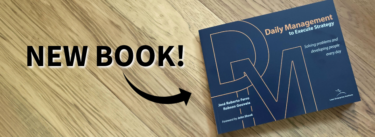Quite simply, converting to a pull system will allow you to deliver more value to your customers than any MRP-driven batch approach. A pull system will connect your customers directly to your shop floor and help you outperform your batch competitors. You will be conforming to your customers’ needs instead of making them conform to the long lead times typical of a batch manufacturer using push scheduling. This shift in focus will allow you to gain market share and grow at your competitor’s expense.
Converting to a pull system will allow you to deliver more value to your customers than any MRP-driven batch approach.
Not enough people understand the power of time as a tremendous competitive weapon. A pull system will help you deliver the shortest lead time in your industry, for example, going from six to eight weeks to one to two days. Whenever a competitor stumbles, such as having a stockout, you will be able to respond quickly and help the customer out. When this happens, you will be able to provide your customer with this needed good at the full book price since the out-of-stock competitor’s price is, in effect, infinite. More importantly, your short lead times get your foot in the door and give you an excellent chance to win the next bid.
Of course, your competitor won’t just sit still and let you take his business. He will respond, but the constraints of his current operational state will limit him. His batch production mindset and push scheduling approach will lock him into six to eight-week lead times that can’t be changed overnight. If you have a pull system with lead times of one to two days, he will have no chance of offsetting that.
Your competitor’s first instinct will be to offer the same one to two-day lead time on a selected group of SKUs, which he can only promise in his batch state by building excess inventory on these items to ensure no further stockouts. But, of course, this response benefits you tremendously, driving up his costs as he adds space to store the inventory and people to move it around—not to mention the financial investment to put it in place. And even so, producing this surplus?still?doesn’t guarantee that he will always have the right stuff on hand.
You will still be gaining market share. So, your competitor’s next step — you guessed it — will be to cut the price. Again, this response will benefit you as it further weakens him financially without even tackling the main problem of having the right stuff on hand. He can price way below his cost while you sell at book price though doing so will prove irrelevant if he doesn’t have any stock on hand.
Why Pull is Fundamentally Better
To understand this better we need to take a deeper dive into the difference between push scheduling and pull scheduling. I consider pull as one of the four lean fundamentals:
- Work to takt time
- One-piece flow
- Standard work
- Pull system
Most companies operate as batch producers, with long setup times and long lead times, driven by the misguided belief of the finance guys that the higher the volume the lower the cost.
Think about pull as the signal that starts everything else in motion. That’s because the lean ideal is “sell one, make one.” If there is no order from a customer (either internal or external), then don’t make anything. All you will be doing is building excess inventory, which Taiichi Ohno described as the No. 1 waste.
Push scheduling based on a forecast is the exact opposite of this approach: “sell one, make 10,000.” Pursuing this policy guarantees you’ll struggle with Ohno’s waste of overproduction every time you make something.
Still, I rarely encounter people who see it this way. Most companies operate as batch producers, with long setup times and long lead times, driven by the misguided belief of the finance guys that the higher the volume, the lower the cost. But, of course, making more than you need in the hopes that you will have what the customer wants drives up your costs. You will need excess space, inventory, and people. There is always the genuine possibility that your forecast was wrong and that you eventually had to write off 7,000 of the 10,000 products you made. No one wants to talk about this, of course.
Before You Can Pull You Must Have Flow
To have pull, you must have flow. You can’t pull against a functionally organized operation that produces in batches: What would you pull against? That’s why companies that aspire to “sell one, make one” can only deliver tremendous value to their customers after they have achieved pull. To achieve this, you need to work to takt time, establish standard work, and of course, have one-piece flow.
To achieve pull you must have flow.
Getting there will take time, but the benefits to your customers and your competitive position are well worth the effort. Oh, and by the way, the side benefits you will get aren’t bad either. Your quality will increase dramatically, your costs will drop, you will free up half your floor space, free up lots of cash, sales and earnings will grow, your culture will improve, and you will have delighted shareholders. At The Wiremold Company, for example, we increased enterprise value by just under 2,500% in just under 10 years.
If you cannot move beyond a functional batch configuration, your only scheduling option will be to push. Also, you will have 25% to 40% too many people, five to six times too much inventory, 40% to 50% too much space, long lead times, and spotty quality. Your ability to serve your customers will depend on your forecasting ability and willingness to hold plenty of excess inventory. Even then, you won’t be connected to your customers, as your system will intentionally disconnect the customer from the people who produce the product. Instead, orders will be received by sales departments or customer service, who will fulfill them from the stock on hand in the warehouse. The shop floor will never see the customer’s orders—all they will see is the forecast, which will be used to tell them: “Just shut up and make the forecast!”
With a pull approach of “sell one, make one,” all your value-creating work is linked directly to the customer. Indeed, you can connect the customer directly to the shop floor so that the entire organization can see and feel the customer. At Wiremold, we created a kanban quantity for every SKU — and we had a lot of SKUs. While this was a whole pallet at times, and sometimes a half a pallet, we mostly had smaller qualities like 5 or 10 boxes worth.
With kanbans for each SKU, we were able to connect the incoming orders directly to the shop floor. So, every time the incoming orders for an SKU reached the kanban quantity, a kanban card would print on the shop floor right next to the cell that made the product. The card was put in the heijunka box, and the product would be made soon afterward. By doing the work this way, our workforce could feel and respond to the customers’ pull throughout the day. They weren’t just building to a forecast and making things that might get sold over the next six months. They were responding to actual orders that a customer wanted right now.
The producer who uses pull and achieves flow rarely has stockouts.
With a push schedule and batch production, you are always making the product in advance of when it is needed, hoping that it?will?be needed. But, unfortunately, this approach ties up your capacity for making things that might get sold—when it would be better to make things that you have already sold that you can ship and collect money for. What a concept!
It’s not that a push-scheduling batch company can’t have reasonable customer service. It’s just that the cost of doing this is very high due to the excess inventory, floor space, and people needed to pull it off. Even then, “out of stock” conditions are common as the forecast is rarely accurate. And stockouts cause many not-too-pretty discussions with customers—many of which end up being about price when they never needed to be.
The producer who uses pull scheduling and achieves flow rarely has stockouts. Even when they do, they can be back on track by the next day instead of six to eight weeks for their push competitors. The customer might not even notice. Price, subsequently, becomes less of an issue as the discussion becomes more about new products, new features, and ways to support the customer’s expansion. You will become more of a partner to your customers rather than just another supplier who they can beat up on price due to your long lead times and spotty quality.
Creating Flow Requires Other Successful Work First
Of course, this is not as easy as it might sound. Our Japanese consultants, Shingijutsu, taught us not to even think about pull until we could work to takt time, establish standard work, and create one-piece flow – such good advice that I pass it on to you.
I learned through experience how to transition to pull at The Wiremold Company. We introduced pull step by step as we went along. First internally for component parts, and then with our suppliers where we demanded daily deliveries to replace the raw materials we used the day before. Doing so helped us move, in one example, from carrying four months of steel on hand to carrying one to two days.
Early on, Wiremold balanced its kaizen schedule along the lines of two setup reduction kaizens, one flow kaizen, and one office kaizen for every four kaizens we did. We understood that it’s impossible to achieve flow if you allow two- and three-hour setups to continue to exist. So we didn’t and averaged a 90% reduction in setup times on every kind of equipment after a one-week kaizen.
We were taught by our Japanese consultants not to even think about pull until we could work to takt time, establish standard work, and create one-piece flow.
Eventually, we had to go to our customers to get them to change their behavior. Wiremold sold its products through electrical distributors. They were local or regional and believed in carrying three to four months of stock of every item under the theory that “you can’t sell from an empty wagon.” They ordered in batches from their own MRP systems, which were all batch in nature. This practice created lumpy demand for us and made it difficult to deliver real value to our distributors. We had established weekly or twice-weekly delivery routines with all our reasonably sized customers. They loved the predictability of the Wiremold truck coming every Tuesday between noon and 2 p.m.
So, we went to our distributors and said, “Hey, we deliver every Tuesday, so why are you carrying four months of our product?”
“Good question,” they said. “What do you suggest?”
“Well,” we replied, “just tell us every day what you shipped, and we will replenish it with the following Tuesday’s delivery. In other words, we want you to pull from us just like we pull from our vendors. Next, we want you to get rid of three months’ worth of inventory, which will free up cash and space for you. Then, we would like you to reinvest a portion of that money in expanding the number of our SKUs that you carry.”
Convincing our distributors to change how they order products from us was not easy as most of them were pretty set in their ways. However, companies that made the changes saw sales of our product increase over 10%, and their earnings grew more than 20%. On our end, orders became less lumpy, allowing us to level-load and be more productive, giving us a chance to deliver even more value to our customers.
So please, to deliver more value, pull, don’t push!
Building a Lean Operating and Management System
Gain the in-depth understanding of lean principles, thinking, and practices.





